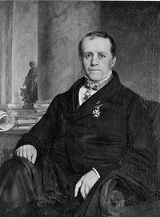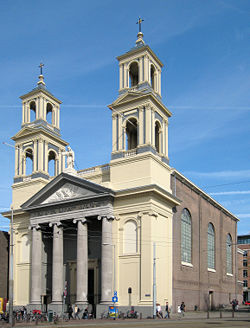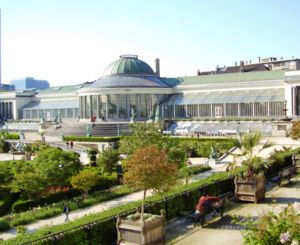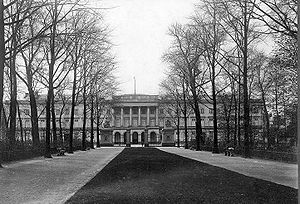
Tilman-François Suys
Encyclopedia
Tilman-François Suys or Tieleman Frans Suys (in Dutch
) (1 July 1783 – 22 July 1864), was a Belgian architect who also worked in the Netherlands
.
Suys completed his architectural education in Paris
, where he studied under Charles Percier
and won the Prix de Rome
in 1812. During his stay in Rome he became a protégé of King William I of the Netherlands
the new king of the Belgian and Dutch provinces unified in the United Kingdom of the Netherlands
. In 1817 he settled in Amsterdam and worked as an architect for the Dutch Crown. In this period his style shows the marks of the Empire style created for Napoleon by his teacher Charles Percier
and Pierre François Léonard Fontaine
.
From 1825 onwards, Suys was employed on a series of royal commissions in Brussels
, a city that, together with The Hague
in Holland had been given the title of capital of the new established kingdom. His projects in Brussels were more severely Neo-Classical
in character. Important creations in Brussels include the great conservatory of the Botanical Garden of Brussels
, which is noted for its innovative use of iron and glass construction, and the Royal Palace.
After the Belgian Revolution
which established Belgium’s independence from the Netherlands, Suys remained in Brussels. He devoted himself mainly to the restoration of the new nation's historic monuments. Some of these projects, especially his Gothic Revival restorations, were not historically accurate, and were later harshly criticized. His renovation (started in 1832) of the medieval Bouchout Castle
at Meise
, near Brussels, included not only Gothic Revival additions but also the earliest example of Flemish Renaissance Revival interior architecture in Belgium.
A beautiful example of the monumental buildings he designed later in his career is the Italianate church of Saint-Joseph (1842–1849) on the Square Frère-Orban in Brussels. Suys continued to carry out commissions in the Netherlands after the revolution such as the Roman Catholic, Mozes and Aaron Church in Amsterdam built between 1831 and 1847.
From 1835 to 1861 Suys was a professor at the Académie Royale des Beaux-Arts
in Brussels, where he taught almost every important Belgian architect of the younger generation such as Hendrik Beyaert
, Joseph Poelaert
and Alphonse Balat
. Through his teaching he deeply influenced later Belgian architecture in both the Neo-classical
and the eclectic or revivalist styles.
Tilman-François Suys was the father and teacher of Léon-Pierre Suys who would also play an important role as an architect and urban planner in 19th-century Belgium.
 Public buildings:
Public buildings:
 Urban planning:
Urban planning:
Private buildings:
Other:
Tomb for the soprano Maria Malibran
on the Cemetery of Laeken
.


Dutch language
Dutch is a West Germanic language and the native language of the majority of the population of the Netherlands, Belgium, and Suriname, the three member states of the Dutch Language Union. Most speakers live in the European Union, where it is a first language for about 23 million and a second...
) (1 July 1783 – 22 July 1864), was a Belgian architect who also worked in the Netherlands
Netherlands
The Netherlands is a constituent country of the Kingdom of the Netherlands, located mainly in North-West Europe and with several islands in the Caribbean. Mainland Netherlands borders the North Sea to the north and west, Belgium to the south, and Germany to the east, and shares maritime borders...
.
Suys completed his architectural education in Paris
Paris
Paris is the capital and largest city in France, situated on the river Seine, in northern France, at the heart of the Île-de-France region...
, where he studied under Charles Percier
Charles Percier
Charles Percier was a neoclassical French architect, interior decorator and designer, who worked in a close partnership with Pierre François Léonard Fontaine, originally his friend from student days...
and won the Prix de Rome
Prix de Rome
The Prix de Rome was a scholarship for arts students, principally of painting, sculpture, and architecture. It was created, initially for painters and sculptors, in 1663 in France during the reign of Louis XIV. It was an annual bursary for promising artists having proved their talents by...
in 1812. During his stay in Rome he became a protégé of King William I of the Netherlands
William I of the Netherlands
William I Frederick, born Willem Frederik Prins van Oranje-Nassau , was a Prince of Orange and the first King of the Netherlands and Grand Duke of Luxembourg....
the new king of the Belgian and Dutch provinces unified in the United Kingdom of the Netherlands
United Kingdom of the Netherlands
United Kingdom of the Netherlands is the unofficial name used to refer to Kingdom of the Netherlands during the period after it was first created from part of the First French Empire and before the new kingdom of Belgium split out in 1830...
. In 1817 he settled in Amsterdam and worked as an architect for the Dutch Crown. In this period his style shows the marks of the Empire style created for Napoleon by his teacher Charles Percier
Charles Percier
Charles Percier was a neoclassical French architect, interior decorator and designer, who worked in a close partnership with Pierre François Léonard Fontaine, originally his friend from student days...
and Pierre François Léonard Fontaine
Pierre François Léonard Fontaine
Pierre François Léonard Fontaine was a neoclassical French architect, interior decorator and designer.Starting from 1794 Fontaine worked in such close partnership with Charles Percier, originally his friend from student days, that it is difficult to distinguish their work...
.
From 1825 onwards, Suys was employed on a series of royal commissions in Brussels
Brussels
Brussels , officially the Brussels Region or Brussels-Capital Region , is the capital of Belgium and the de facto capital of the European Union...
, a city that, together with The Hague
The Hague
The Hague is the capital city of the province of South Holland in the Netherlands. With a population of 500,000 inhabitants , it is the third largest city of the Netherlands, after Amsterdam and Rotterdam...
in Holland had been given the title of capital of the new established kingdom. His projects in Brussels were more severely Neo-Classical
Neoclassical architecture
Neoclassical architecture was an architectural style produced by the neoclassical movement that began in the mid-18th century, manifested both in its details as a reaction against the Rococo style of naturalistic ornament, and in its architectural formulas as an outgrowth of some classicizing...
in character. Important creations in Brussels include the great conservatory of the Botanical Garden of Brussels
Botanical Garden of Brussels
The Botanical Garden of Brussels stands on Rue Royale, near the Northern Quarter financial district in Brussels.Originally founded in 1826 and partly designed by architect Tilman-François Suys, the main orangery is composed of a central rotunda with a dome, and two side aisles with windows at the...
, which is noted for its innovative use of iron and glass construction, and the Royal Palace.
After the Belgian Revolution
Belgian Revolution
The Belgian Revolution was the conflict which led to the secession of the Southern provinces from the United Kingdom of the Netherlands and established an independent Kingdom of Belgium....
which established Belgium’s independence from the Netherlands, Suys remained in Brussels. He devoted himself mainly to the restoration of the new nation's historic monuments. Some of these projects, especially his Gothic Revival restorations, were not historically accurate, and were later harshly criticized. His renovation (started in 1832) of the medieval Bouchout Castle
Bouchout Castle
Bouchout Castle is a castle in the Flemish town of Meise, Belgium. In the 12th century, this territory of the young Duchy of Brabant was strategically positioned between the County of Flanders and the Berthout family, lords of Grimbergen...
at Meise
Meise
Meise is a municipality located in the Belgian province of Flemish Brabant. The municipality comprises the towns of Meise proper and Wolvertem , and, several smaller villages like Sint-Brixius-Rode, Oppem, Meusegem, Impde/Imde, Rossem, Westrode and quarters as Bouchout, Nerom and Slozen. As of...
, near Brussels, included not only Gothic Revival additions but also the earliest example of Flemish Renaissance Revival interior architecture in Belgium.
A beautiful example of the monumental buildings he designed later in his career is the Italianate church of Saint-Joseph (1842–1849) on the Square Frère-Orban in Brussels. Suys continued to carry out commissions in the Netherlands after the revolution such as the Roman Catholic, Mozes and Aaron Church in Amsterdam built between 1831 and 1847.
From 1835 to 1861 Suys was a professor at the Académie Royale des Beaux-Arts
Académie Royale des Beaux-Arts
The Académie Royale des Beaux-Arts in Brussels is an art school, founded in 1711.The faculty and alumni of ARBA include some of the most famous names in Belgian painting, sculpture, and architecture: James Ensor, Rene Magritte, and Paul Delvaux...
in Brussels, where he taught almost every important Belgian architect of the younger generation such as Hendrik Beyaert
Hendrik Beyaert
Hendrik Beyaert or Henri Beyaert was a Belgian architect.He was born in Kortrijk, Belgium on 29 July 1823 and died in Brussels 22 January 1894. He is considered one of the most important Belgian architects of the 19th-century....
, Joseph Poelaert
Joseph Poelaert
Joseph Poelaert was a Belgian architect.- Life :Born in Brussels to Philip Poelaert , a former architecture student at the Académie Royale des Beaux-Arts in Brussels, Poelaert also trained there under Tilman-François Suys, and then in Paris under Louis Visconti and Jean-Nicolas Huyot.Poelaert...
and Alphonse Balat
Alphonse Balat
Alphonse Hubert François Balat was a Belgian architect.He studied at the Academie of Namur and obtained his degree in architecture from the Academy of Antwerp in 1838....
. Through his teaching he deeply influenced later Belgian architecture in both the Neo-classical
Neoclassical architecture
Neoclassical architecture was an architectural style produced by the neoclassical movement that began in the mid-18th century, manifested both in its details as a reaction against the Rococo style of naturalistic ornament, and in its architectural formulas as an outgrowth of some classicizing...
and the eclectic or revivalist styles.
Tilman-François Suys was the father and teacher of Léon-Pierre Suys who would also play an important role as an architect and urban planner in 19th-century Belgium.
List of works
Churches:- Reconstruction (after a fire) of the "Ronde Lutherse KerkRonde Lutherse Kerk (Amsterdam)The Ronde Lutherse Kerk or Koepelkerk is a former Lutheran church in Amsterdam, located at the Singel. The church can be easily seen from the Singel by its copper dome.-History:...
" in AmsterdamAmsterdamAmsterdam is the largest city and the capital of the Netherlands. The current position of Amsterdam as capital city of the Kingdom of the Netherlands is governed by the constitution of August 24, 1815 and its successors. Amsterdam has a population of 783,364 within city limits, an urban population...
. (in collaboration with Jan de Greef). 1822-1826. - Church of Mozes and Aron, (Mozes en Aäronkerk) in AmsterdamAmsterdamAmsterdam is the largest city and the capital of the Netherlands. The current position of Amsterdam as capital city of the Kingdom of the Netherlands is governed by the constitution of August 24, 1815 and its successors. Amsterdam has a population of 783,364 within city limits, an urban population...
, (1837–1841) - Groenmarktkerk in HaarlemHaarlemHaarlem is a municipality and a city in the Netherlands. It is the capital of the province of North Holland, the northern half of Holland, which at one time was the most powerful of the seven provinces of the Dutch Republic...
, (1843–1844) - Saint-Joseph, in BrusselsBrusselsBrussels , officially the Brussels Region or Brussels-Capital Region , is the capital of Belgium and the de facto capital of the European Union...
, Square Frère-Orban, (1842–1849) - Saint-Martin, in Jemeppe-sur-SambreJemeppe-sur-SambreJemeppe-sur-Sambre is a Walloon municipality located in the Belgian province of Namur. On 1 January 2006 the municipality had 17,990 inhabitants...
, (Gothic Revival), (1842) - Saint-George, (Sint-Joriskerk), in Gothic Revival style, in Antwerp, (1847–1850)

- Great conservatory of the Jardin Botanique in BrusselsBrusselsBrussels , officially the Brussels Region or Brussels-Capital Region , is the capital of Belgium and the de facto capital of the European Union...
(1829–1834) - Royal Palace in BrusselsBrusselsBrussels , officially the Brussels Region or Brussels-Capital Region , is the capital of Belgium and the de facto capital of the European Union...
(1820–1829) - Palace of AcademiesPalace of AcademiesThe rather austere neoclassical Academy Palace , in Brussels, establishes the harmonious ensemble of the capital's Place Royale/Koningsplein and the Brussels Park....
in BrusselsBrusselsBrussels , officially the Brussels Region or Brussels-Capital Region , is the capital of Belgium and the de facto capital of the European Union...
, formerly the palace of the Prince of OrangePrince of OrangePrince of Orange is a title of nobility, originally associated with the Principality of Orange, in what is now southern France. In French it is la Principauté d'Orange....
. Completion of the designs of Charles Vander Straeten

- Planning of the new Leopold QuarterLeopold QuarterThe Leopold Quarter is a quarter of Brussels, Belgium. Today the term is sometimes confused with European Quarter, as the area has come to be dominated by the institutions of the European Union and organisations dealing with them, although the two terms are not in fact the same, with the Leopold...
in BrusselsBrusselsBrussels , officially the Brussels Region or Brussels-Capital Region , is the capital of Belgium and the de facto capital of the European Union...
, (1830-)
Private buildings:
- Château Waroquée, (Castle of Mariemont), in MorlanwelzMorlanwelzMorlanwelz is a Walloon municipality located in the Belgian province of Hainaut. On January 1, 2006 Morlanwelz had a total population of 18,595. The total area is 20.26 km² which gives a population density of 918 inhabitants per km²...
, (1830–1836) (destroyed by fire in 1960) - Bouchout CastleBouchout CastleBouchout Castle is a castle in the Flemish town of Meise, Belgium. In the 12th century, this territory of the young Duchy of Brabant was strategically positioned between the County of Flanders and the Berthout family, lords of Grimbergen...
in MeiseMeiseMeise is a municipality located in the Belgian province of Flemish Brabant. The municipality comprises the towns of Meise proper and Wolvertem , and, several smaller villages like Sint-Brixius-Rode, Oppem, Meusegem, Impde/Imde, Rossem, Westrode and quarters as Bouchout, Nerom and Slozen. As of...
(restoration and rebuilding in Gothic Revival), (1832-) - Egmont PalaceEgmont PalaceThe Egmont Palace is a large mansion at the Wolstraat / Rue aux Laines and the Kleine Zavel / Petit Sablon Square in Brussels, Belgium...
in BrusselsBrusselsBrussels , officially the Brussels Region or Brussels-Capital Region , is the capital of Belgium and the de facto capital of the European Union...
, (extension of left wing), (1830-)
Other:
Tomb for the soprano Maria Malibran
Maria Malibran
The mezzo-soprano Maria Malibran , was one of the most famous opera singers of the 19th century. Malibran was known for her stormy personality and dramatic intensity, becoming a legendary figure after her death at age 28...
on the Cemetery of Laeken
Laeken Cemetery
The Laeken Cemetery , located in Laeken in the northern part of Brussels, is one of the major cemeteries in Belgium.-Description:...
.
External links



